‘A Consciousness Free of Occupation’: Bil’in Marks 10 Years of Popular Nonviolent Struggle
PALESTINE ISRAEL GAZA GENOCIDE, 9 Mar 2015
The village that managed to unite the world behind the spirit of nonviolent Palestinian protest marks not only a decade of tear gas, night raids and tragedy, but also of co-resistance and victories in its struggle against settlements, the separation barrier and the occupation.
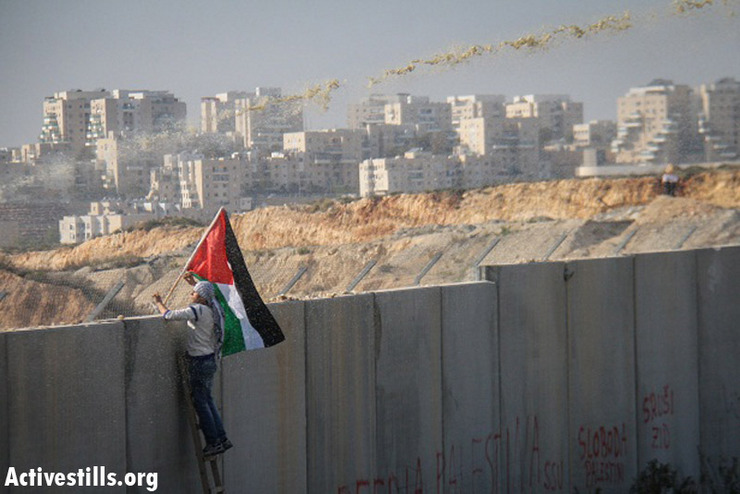
A demonstrator waves a Palestinian flag as he looks over the wall during the weekly protest against the wall and the occupation in the West Bank village of Bil’in, January 4, 2012. (Photo by: Guest photographer Hamde Abu Rahma/ Activestills.org)
26 Feb 2015 – Anyone who has visited the West Bank village of Bil’in on a recent Friday might think, just for a second, that they were back in 2005. At first glance, it seems like nothing has changed since the days of the first protests, which began 10 years ago this month.
Now, as then, the protesters — mostly villagers, some supportive Israelis and internationals — gather in the heart of the village following the Friday noon prayers. We march and chant until we passed built-up part of the village. Now, just like then, the soldiers are waiting on the hill across the valley. They don’t waste any time shooting large volleys of tear gas in order to disperse the protest. Some of the protesters quietly break away, while village youth respond to the soldiers by throwing stones; the soldiers continue with the gas, charging toward the village in their jeeps in order to chase away the protesters. Within two hours it is all over.
But in reality, much has changed in Bil’in. Over the course of the past 10 years, hundreds of protesters have been to the village. The Israeli Defense Ministry cleared olive trees from entire tracts of land and erected the separation barrier. A petition the villagers filed in Israel’s High Court of Justice succeeded in moving the fence — and to some degree, the soldiers. Only recently did they return to the previous route of the fence — the same one the court ruled against. Hundreds have been wounded, two protesters were killed, hundreds have been arrested and imprisoned for years at a time.
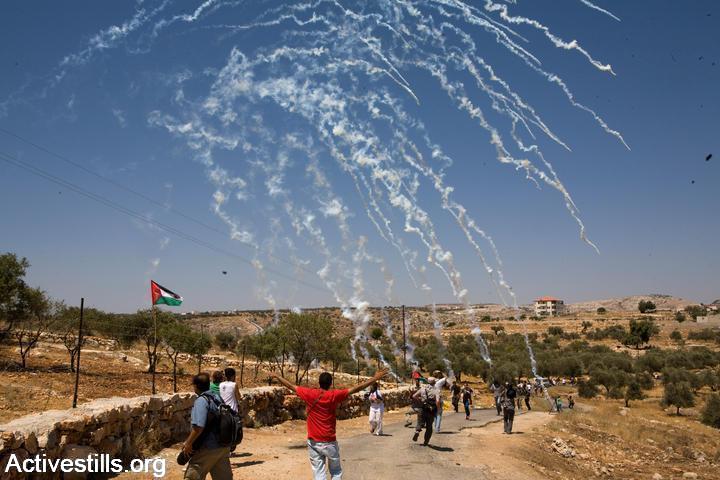
Protesters run for cover after Israeli soldiers shoot tear gas during a demonstration in Bil’in. (photo: Keren Manor/Activestills.org)
Over the past 10 years the struggle has seen ups and downs. Its biggest achievement was winning back hundreds of dunams of agricultural land, a victory which made Bil’in a symbol of popular resistance to the separation fence, settlements, and military rule in the Occupied Territories across the world. A film made by one of the villagers was nominated for an Oscar. Former presidents and prime ministers from far away lands journeyed to the village. Deep friendships developed among the activists. Those who were small children at the start of the struggle are now among its leaders.
But something else happened, too.
“The most important thing that changed is the culture of the people of Bil’in, says Abdullah Abu Rahmah, an activist in the village’s Popular Struggle Committee, which organizes the protests. “Over the years we have managed to free our minds from the occupation. The Israeli occupation is not just soldiers standing on our land, it is the control of our thoughts, it is the fear that every Palestinian has when staring down the occupation. And we have overcome that, the fear of the soldiers, of police, the Shin Bet, the courts — we express ourselves freely and act to realize our rights. In Bil’in, we are educating the next generation not to be afraid.”
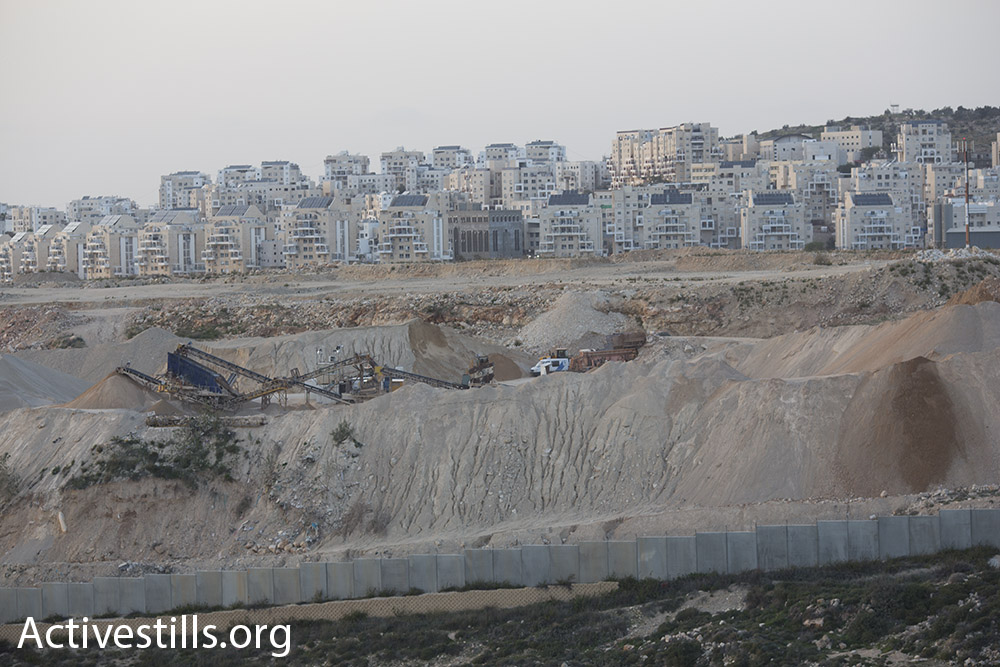
Beyond the separation wall, bulldozers expand the Modi’in Illit settlement bloc. (photo: Oren Ziv/Activestills.org)
On Friday March 27, the residents of Bil’in will mark 10 years of popular struggle against the separation barrier. In this small town near Ramallah (it has fewer than 2,000 residents), whose name in Arabic means, “without a spring,” will hold a large celebratory festival, with senior officials from the Palestinian Authority and Knesset candidates from the Arab Joint List.
“Bil’in’s success is not just the success of the villagers; we wouldn’t have been ale to do it alone,” explains Abu Rahmah, who over the years has become active in struggles and protests across the West Bank, and was recognized by the European Union as a Human Rights Defender committed to nonviolent protest. “This week we want to say thank you to anyone who ever took part in the protests, Palestinians from the village and the West Bank, Israelis and foreigners. Without our partners we wouldn’t have been able to get our land back.”
The Mission: Protect the illegal fence
The bulldozers first arrived in Bil’in in February 2005. As it was planned, the separation barrier was to steal some 1,950 dunams (480 acres) of the village’s agricultural land — almost half of Bil’in’s total land, which is the main source of income for its residents. Like in other villages that have embarked on the path of popular struggle following the suppression of the Second Intifada, Bil’in’s residents have attempted to stop the bulldozers with their bodies. From day one they invited Israeli and international activists to join their protests. The main group that answered their call and is still active in the village to this day is “Anarchists Against the Wall.” This might be a good time to disclose that I also came to protest in the village, and remain active in the protests, albeit less so over the past year.
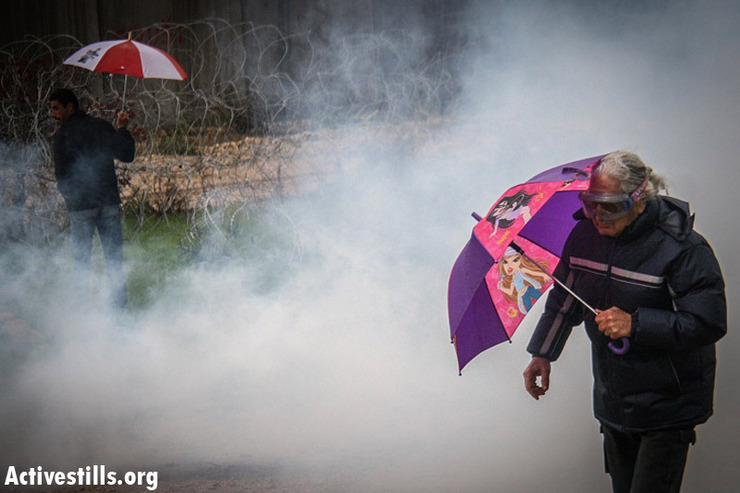
An Israeli demonstrators tries to avoid tear gas shot by the Israeli army during the weekly protest against the wall and the occupation in the West Bank village of Bil’in, December 21, 2012. (photo by: Guest photographer Hamde Abu Rahma/ Activestills.org)
But the fence was built. Behind it, on land left over on the Israeli side, the Israeli government began expanding the ultra-Orthodox settlement of Modi’in Ilit. Two and a half years later, the High Court ruled that the fence’s route was illegal. The justices ruled that security considerations were not the primary consideration behind the barrier’s route, but rather plans to expand the nearby settlement — on Bil’in’s land. They struck down the existing, already-built route of the barrier.
“You need to understand that that land wasn’t only a national symbol, it was worth money,” explains Muhammad Khatib, one of the village’s popular committee activists. “They took a lot of money from the villagers and gave it to the settlement, which was supposed to be expanded. But we succeeded in returning that money to the people on a personal level.”
But for the next four years the villagers continued to march down to the fence and protest against it, the same fence the High Court had already ruled was illegal, but which the army hadn’t bothered to move. Instead, the army continued to protect the fence. It was during that time that Bassem Abu Rahmah was killed when a tear gas canister was fired directly at his chest (no soldier has ever stood trial over the shooting), and his sister Jawaher suffocated to death from tear gas inhalation (the Israeli army claims she died of inadequate of negligible medical care that she received after inhaling the tear gas.) The barrier was only moved in 2011. Six hundred dunams (148 acres) of agricultural lands were returned to the village, but over 1,000 remain on the other side of the new barrier, where the Jewish settlement continues to expand. Bil’in’s residents continue to demand the return of all of their land.
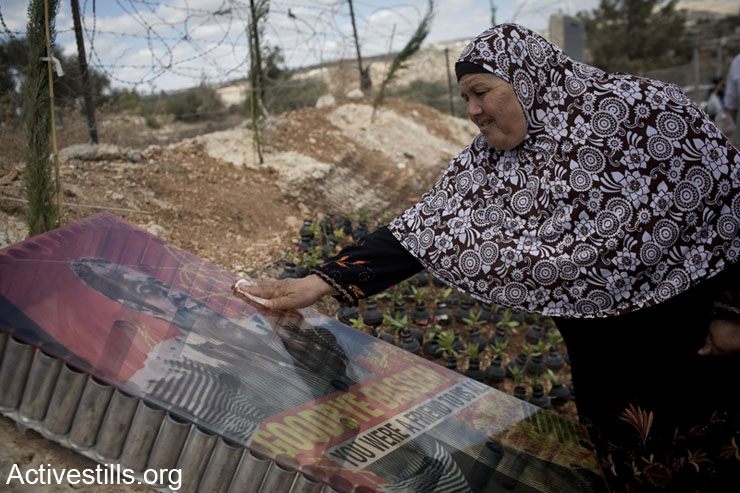
Palestinian Subhiya Abu Rahme cleans the memorial monument of her son, Bassem who was shot to death by an Israeli soldier during a protest in the village in 2009; October 4, 2013. The garden was set with many flowers put in empty gas canisters and inaugurated during the eight Bil’in popular struggle conference.
The protests have grown smaller over the past year (one Israeli television news program even went to so far as to declare the popular struggle over), and in recent months the army has changed its policy. Instead of protecting the wall itself, soldiers are positioned along the old route of the fence and are sent into the village itself. “It’s a stupid move on their part, because people see the soldiers coming and come out of their homes to protest against them — people who wouldn’t otherwise go to the demonstrations against the now-far-away wall,” Abu Rahmah says. “We understand how the army works. Every six months a new regional commander rotates in and thinks that he is going to be the one to finally put an end to the demonstrations in Bil’in. He arrives like a lion, thinking that he will break us, but within a couple of months he gives up and just tries to make do until they come and replace him.”
As Muhammad Khatib explains, the villagers are no longer fighting to regain their agricultural lands, which are now being watered by irrigation lines and connected to electricity, they are fighting the army’s plans to demolish the buildings that have been built on the reclaimed land, including a house, agricultural warehouses, a coffee shop and a swimming pool, which was recently completed and will hopefully serve the village children this summer.
The joke is on Cellcom
Bil’in was neither the first nor the last village to embark on an unarmed popular struggle against the separation barrier. And yet, Bil’in has been holding protests for 10 consecutive years, turning it into one of the best-known symbols of the Palestinian popular struggle worldwide.
“When people ask me if I still go to the territories, pretty often they ask, ‘do you still go to Bil’in?’ even if I am protesting somewhere else entirely,” says Michal Sappir, a musician, writer and translator who is active with Anarchists Against the Wall. “Bil’in served as an example for the other villages of what tactics should be used at a given stage in the struggle,” adds Kobi Snitz, who is also active in the group. “They combined creativity, direct action, a knowledge of how to use the media and perseverance — you can see how other villages adopted [their tactics] over the years.”
What is so unique about Bil’in that enabled its struggle to continue for so long? Beyond international fame, the moral and financial support, and the boost from the High Court victory — everyone agrees that creativity always played a central role in the struggle’s success. “The original ideas, the fact that we are constantly renewing our tactics, that is what helped with the media and brought people here, as well as the films that were made about the village — they all brought more support,” Khatib suggests.
It is difficult to list all of the creative and surprising direct actions that the village used in its struggle. Over the years they dressed up as characters from the film “Avatar,” as security prisoners in Israeli prisons when mass hunger strikes were taking place, as soccer players during the World Cup, as leaders like Gandhi, Nelson Mandela and Martin Luther King. They combined music and art, from traditional Palestinian dabka, to a Holocaust survivor pianist who performed on a truck that drove along the entire length of the separation barrier, to art exhibitions that included pieces hung on olive trees marked for removal by the army, to performances by the Jenin Freedom Theater — and a troupe of Basque musicians who marched while ringing traditional bells.
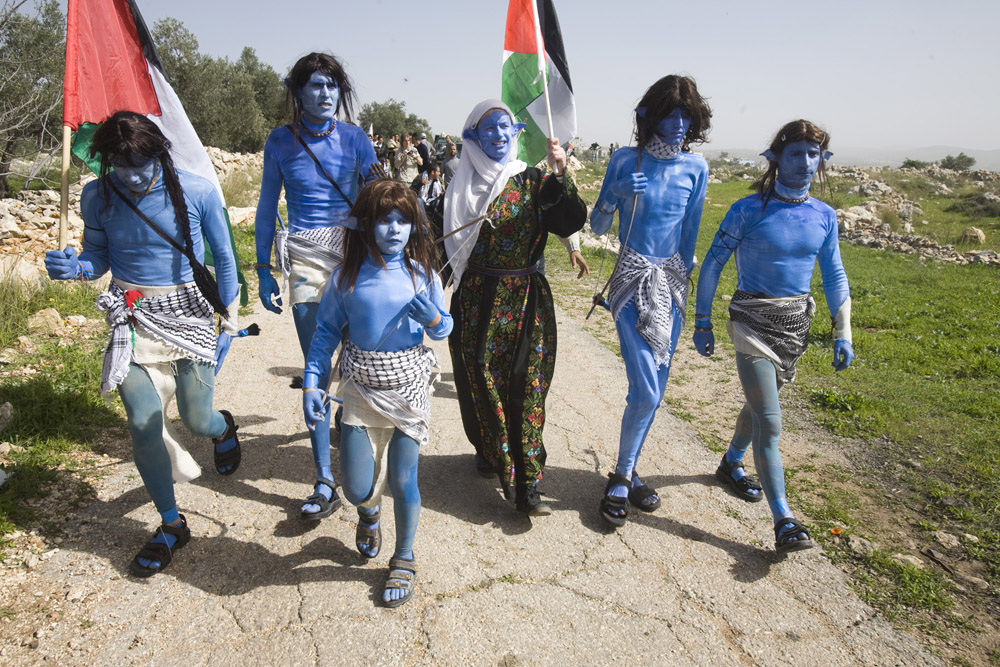
Palestinian and Israeli protesters dress up as characters from the film ‘Avatar’ during a demonstration against the wall in Bil’in. (photo: Oren Ziv/Activestills.org)
When major Israeli cellular company Cellcom put out a commercial featuring soldiers kicking a soccer ball back and forth over the wall to Palestinians, the village produced a video response in which they kick balls to soldiers who respond with tear gas. Spent tear gas grenades that were shot at protesters became plants and flowers. Protesters held up mirrors and used the sunlight to project the words “no wall” onto the soldiers, and many times gave lectures to the soldiers explaining the history of the occupation. Village residents tied themselves to trees, established an “outpost” on the other side of the wall, took over under-construction apartments in the settlement of Modi’in Ilit, led bicycle tours along the route of the wall, stood in solidarity with imprisoned Israeli draft refusers and recently sent messages of support to African Americans struggling against police violence in Ferguson and the rest of the United States. And that, of course, is only a partial list.
Even the military prosecutor gets creative
In the face of these persistent and myriad tactics, the army has tried, time and time again, to stop to protests. The army has, at times, declared curfews and closures on the village, access roads were blocked in order to prevent supporters from joining the protests, demonstrators were arrested and sometimes even shot. Bil’in’s fields have turned into the army’s laboratory of sorts over the years, a place to try out new weapons, such as sponge-tipped bullets, sonic weapons (“the scream”), “the skunk” water canons and more. At one point, soldiers raided the village every night, sometimes in order to make arrests, but most of the time just to fire tear gas and stun grenades into residents’ courtyards as a form of collective punishment. In response, the village’s popular committee organized night demonstrations along the wall with flashlights and candles.
WATCH: Israeli soldiers conduct night raid on Bil’in
httpv://www.youtube.com/watch?v=DJQlp-wtZXE
“The most important thing that strengthened us is the cohesion we were able to create in the village,” says Abu Rahmah. “In the beginning we were already bogged down by internal problems, conflicts between people, families. But the difficulties united us and today the whole village is like one family that stands behind the struggle, even if not everybody goes out to protest. Without that we wouldn’t have been able to withstand the army’s collective punishment. The army tried to spread lies about the protest leaders or to incite against the Israelis and internationals who come here, it didn’t work. They tried to buy people with promises, and that didn’t work. They banned the entire village from working in Israel — and that didn’t work either.”
“In Beit Sira (a village near Bil’in that is also affected by the barrier, H.M.) they carried out actions and held demonstrations that were much more hardcore than ours. But most of the residents there work in Israel, and after three months of protests they canceled their permits. Fathers came home and attacked their children, their neighbors, telling them, ‘if you don’t stop, how will we put food on the table?’ That is how their struggle ended.” According to the popular committee, in addition to the two people killed over the past 10 years, some 1,500 protesters have been wounded and evacuated by ambulances, five of whom were seriously wounded, including Israelis and internationals. Soldiers and Border Police officers have also been wounded, mostly lightly, save for one soldier who lost sight in one eye after being hit with a stone. Two hundred villagers and dozens of Israelis and internationals have been arrested, but only the Palestinians were given serious prison sentences.
Abdullah Abu Rahmah and his brother Adib have each served more than a year in prison for their roles in organizing the protests, and Muhammad Khatib was also sentenced to a year in prison. Just this past week Abu Rahmah was given a suspended sentence and a NIS 5,000 fine ($1,200) for standing in front of a bulldozer during a protest in another village.
“Bil’in is a place where the army tried, and continues to try, to develop its tactics and strategies for confronting nonviolent protest. It doesn’t work with weapons — they arrest the leaders,” says Atty. Gaby Lasky. Lasky — who is a Tel Aviv-Jaffa city councilwoman and a Knesset candidate with Meretz — has, together with other lawyers in her office, represented most of those arrested in Bil’in over the years, myself included. “In the trials from Bil’in we saw the creativity of the military prosecutor’s expressed in the types of indictments they would bring against nonviolent activists. Take for example the attempt to send Abdullah [Abu Rahmah] to prison for possession of weapons after he put together an exhibition consisting of spent tear gas canisters that the army fired at protesters. It isn’t the person who illegally opens fire that is sent to jail — it is the people they shoot. Another charge they bring up in the military courts, and which does not exist in Israeli law, is calling on people to participate in protests. The very call to express opposition to the occupation is a criminal offense.”
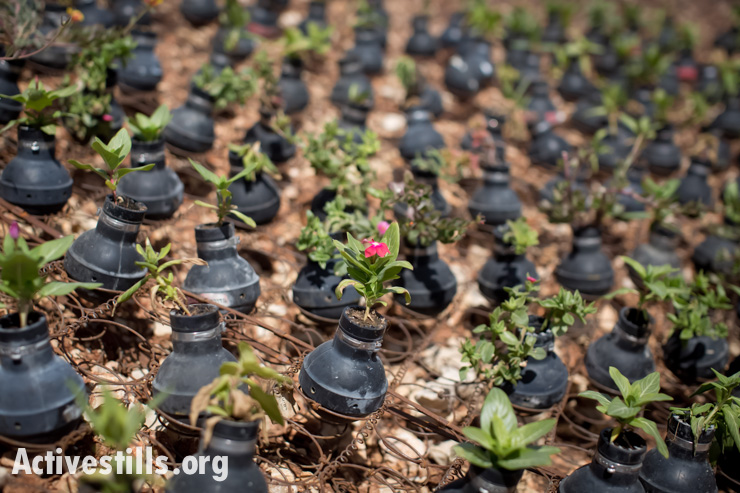
Flowers planted in used tear gas canisters on the sport where Bassem Abu Rahmah was shot and killed with a tear gas grenade fired by Israeli soldiers during a protest against the wall on 2009, in West Bank village of Bil’in, October 4, 2013. (photo: Oren Ziv/Activestills.org)
One of the most difficult things that we began to see is the use of children in order to incriminate adults. They arrest small children in the middle of the night, put them in handcuffs, prevent them from sleeping, they don’t tell their parents where they are, they interrogate them without the presence of a youth investigator. All this is done not to make them confess, but rather as part of ‘intelligence gathering interrogations’ intended to obtain incriminating testimony about others. Unfortunately, even the courts are part of this practice, as they often do not uphold the children’s rights, use their testimonies in order to convict the popular struggle’s leadership and hand down sentences that aren’t even close to the types of sentences that are acceptable in Israel for nonviolent offenses. The entire system joined the effort to destroy Bil’in as a symbol.”
The IDF Spokesperson’s Office did not approve my request to an interview about the army’s policies in BIl’in, nor did it respond to written questions.
Go protest in Tel Aviv
Along with the pride over the struggle’s successes and persistence, many activists have grown frustrated over the years. Members of the Popular Struggle Committee, for instance, feel the dwindling presence of Anarchists Against the Wall at protests, and that protests and actions inside Israel are becoming more rare — something that the village always saw as an important venue for its struggle. “As we become more successful on the international front, and the various BDS movements are bearing fruit, I feel that Israeli group has stopped growing, and I want to see more Israelis [standing] with us,” says Abu Rahmah. “At the start of the struggle, the Israelis would distribute fliers in Tel Aviv. They have that ability, we don’t, so we hope that they take advantage of it.”
“Israeli supporters were always our partners,” Khatib adds. “It’s true that it is our struggle, but they are partners in every way. It is important that more Israelis come so that we can show that they too oppose the occupation, that they affect public opinion in Israel, especially now that the Israeli public is moving toward the radical right. They must demonstrate their opposition to segregation.”
If you talk to many Israeli activists, however, there is a feeling that there is nobody to talk to in the Israeli public. “Of course it is easier to do something in Tel Aviv than in Bil’in, but for what purpose?” says Roi Wagner, an activist with the Anarchists. “There are people who speak directly the Israeli public, but they aren’t the same ones who go to Bil’in. The sense is that those who try don’t have any impact in Israel, which drains their motivation.”
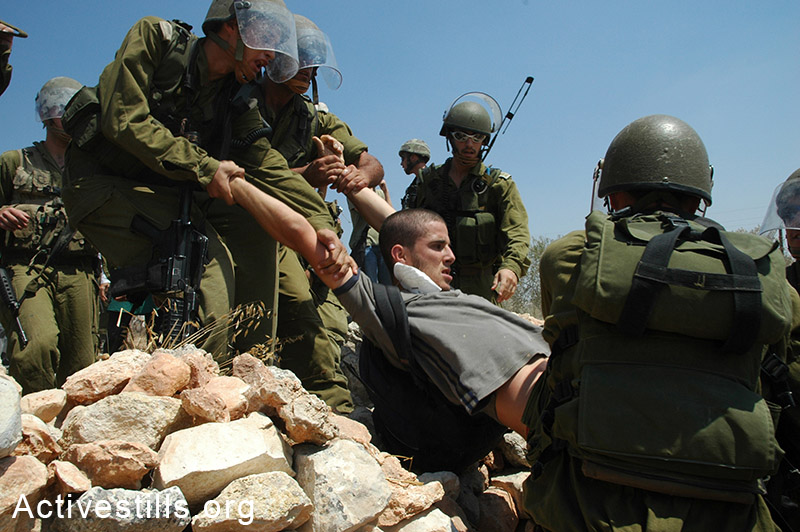
Israeli activist Ben Ronen is arrested by the army during the weekly protest against the building of the Wall in the West Bank village of Bil’in, August 26, 2005. (photo: Yotam Ronen / Activestills.org)
“Our Palestinian partners are too optimistic for the Israeli public, or about the power we have,” Snitz adds. “However effective we are in [influencing] Israeli society, it is rooted in the fact that we are actually outsiders of sorts, and we aren’t counted in the political discourse. It just doesn’t work to argue in Israel that the occupation is bad because of the things it does to Palestinians, because even those who oppose it think in the terms of ‘the occupation corrupts the Jews.’”
One of the things that makes it hard to recruit people to the struggle from the Israeli side is the feeling that women have less of a place in the village. Never mind the fact that women play significant leadership roles in a few other Palestinian villages in the West Bank. In Bil’in, however, the women almost never come to the protests. “We tried in the past to find a place for women in Bil’in, and we are aware of the problem and we’re trying to address it. It is important, but a lot of women actually prefer to go to other places,” Sappir says.
“As far as I’m concerned, even if there are less-pleasant moments there, with the male-dominated dynamic, it is not a reason to abandon the struggle. What is important to me is the struggle against segregation; the fact is that Israelis meet Palestinians — it doesn’t happen like this anywhere else. Certainly not facing danger and funerals, along with weddings and celebrations, together. People ask me ‘how do they treat you there?’ It doesn’t even cross their minds that we may just be friends. And that has great value.”
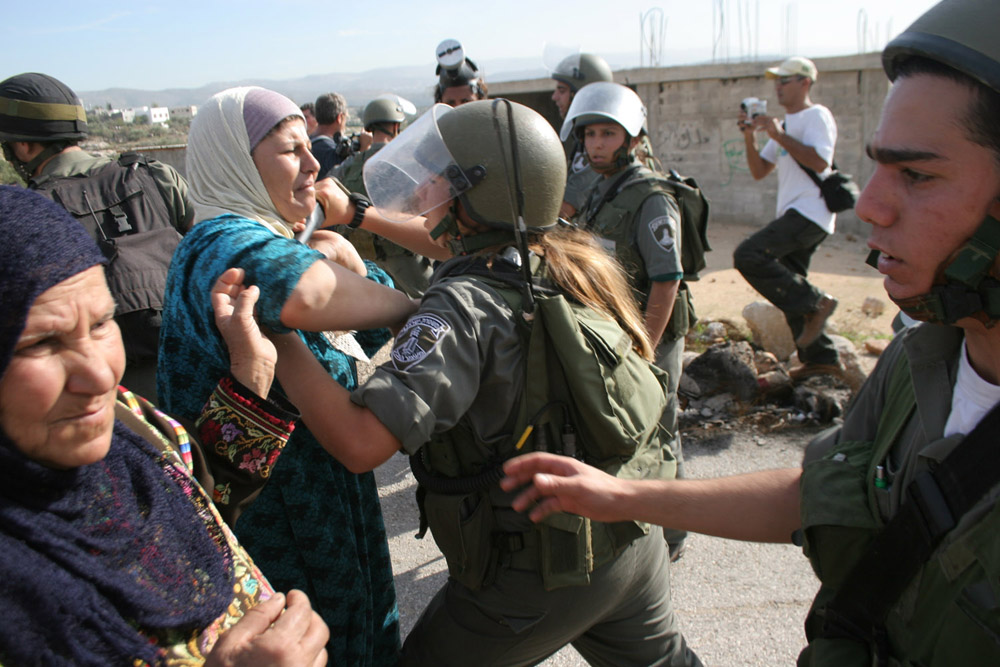
Palestinian women confront Border Police soldiers during a demonstration in Bil’in. (photo: Oren Ziv/Activestills.org)
Don’t throw stones, tear down checkpoints
The struggle is currently facing difficulties within Palestinian society as well. From the beginning, members of the village’s popular struggle committee have aspired to spread the tools they’ve developed to other villages, and to make the make nonviolence the leading form of Palestinian resistance to the occupation. For a decade they’ve been traveling to other villages, encouraging people to go out and protest, taking part in protest actions like establishing the ‘Bab a-Shams’ protest camp, and more recently, ‘Bab al-Quds, and more. An yet, the struggle hasn’t expanded in any dramatic way.
Activists cite the trauma of Israel’s suppression of the Second Intifada, internal Palestinian divisions, tough economic times, the fear brought about by the instability following the Arab Spring and the problematic role of the Palestinian Authority, which expresses on paper (and sometimes even in practice), but never fully commits itself to advancing the struggle.
“The protests provide a grassroots alternative to the institutional activities of the Palestinian political parties and the PA. They provide a political alternative to the elite,” Wagner extolls. “Even if the protests have subsided, and even when there is no vision, short- or long-term, it is important to preserve them as an infrastructure and a body of knowledge, personal connections, meaningful dialogue and skills for the day after. Hopefully, one day soon, we will be able to put it to use on a broad scale, effectively.”
“Makor Rishon [an Israeli newspaper identified with the national-religious movement, H.M.] was correct when it wrote that the struggle is at a weak point, but what you see is only what is on the surface,” Snitz adds. “It is easier to miss the quieter movements in Palestinian society, what is happening in the south Hebron hills, the Nablus area, Gush Etzion, Mishor Adumim, etc. All of the various initiatives are intertwined. It is a movement with the ability to set a lot of things into motion at the right time. That is how it was before the First Intifada, when there wasn’t anyone positioned to control the movement, but there was somebody there to direct it. The infrastructure is much stronger today.”
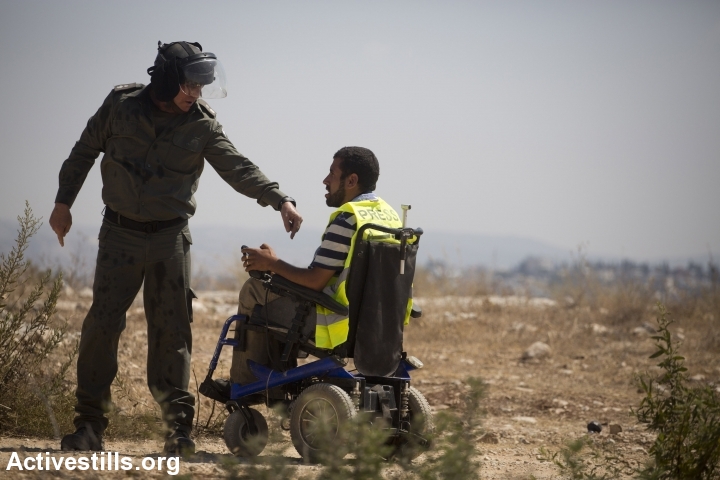
An Israeli soldier speaks to a wheelchair-bound Palestinian protester during a demonstration in Bil’in. (photo: Oren Ziv/Activestills.org)
“It is true that we expected to be further along after 10 years. We expected that all of the villages in the West Bank would take part in the struggle, but the situation on the ground makes that difficult,” Abu Rahmah concludes. “And yet, as I said before, we are working on a new consciousness free of occupation, and that takes time. This week I was in Silwad, two days ago I was in Turmusaya, and before that at the Bab al-Quds camp. Things are happening.”
“Look at the village Azun. The army put a new barrier at the entrance of the village. Two months ago we went there and encouraged them not to throw stones. I asked them what their main problem is, and they answered: this new barrier. So I told them, ‘What do you think about just going there and removing it?’ And that’s what happened. Some 200-300 of us came, and we just took apart the gate. Now they put up a new one, so we’ll do it again. The same thing happens in other places.”
“We, the popular committee, need more time. We aren’t a political party, but a cocktail of activists, and in order for this type of thing to work, you need time. The occupation isn’t going anywhere, but neither are we.”
____________________________
Haggai Matar is an Israeli journalist and political activist. After writing for Ha’aretz and Ma’ariv (where he became chairman of the journalists’ union chapter), he is now the co-editor of Local Call, +972′s sister site in Hebrew. He was awarded the 2012 Anna Lindh Mediterranean Journalist Award for his +972 series on the separation wall.
This article was first published on +972′s Hebrew-language sister site, Local Call. Read it in Hebrew here.
JOIN THE BDS-BOYCOTT, DIVESTMENT, SANCTIONS CAMPAIGN TO PROTEST THE ISRAELI BARBARIC GENOCIDE OF PALESTINIANS IN GAZA.
DON'T BUY PRODUCTS WHOSE BARCODE STARTS WITH 729, WHICH INDICATES THAT IT IS PRODUCED IN ISRAEL. DO YOUR PART! MAKE A DIFFERENCE!
7 2 9: BOYCOTT FOR JUSTICE!
DISCLAIMER: The statements, views and opinions expressed in pieces republished here are solely those of the authors and do not necessarily represent those of TMS. In accordance with title 17 U.S.C. section 107, this material is distributed without profit to those who have expressed a prior interest in receiving the included information for research and educational purposes. TMS has no affiliation whatsoever with the originator of this article nor is TMS endorsed or sponsored by the originator. “GO TO ORIGINAL” links are provided as a convenience to our readers and allow for verification of authenticity. However, as originating pages are often updated by their originating host sites, the versions posted may not match the versions our readers view when clicking the “GO TO ORIGINAL” links. This site contains copyrighted material the use of which has not always been specifically authorized by the copyright owner. We are making such material available in our efforts to advance understanding of environmental, political, human rights, economic, democracy, scientific, and social justice issues, etc. We believe this constitutes a ‘fair use’ of any such copyrighted material as provided for in section 107 of the US Copyright Law. In accordance with Title 17 U.S.C. Section 107, the material on this site is distributed without profit to those who have expressed a prior interest in receiving the included information for research and educational purposes. For more information go to: http://www.law.cornell.edu/uscode/17/107.shtml. If you wish to use copyrighted material from this site for purposes of your own that go beyond ‘fair use’, you must obtain permission from the copyright owner.
Read more
Click here to go to the current weekly digest or pick another article:
PALESTINE ISRAEL GAZA GENOCIDE: